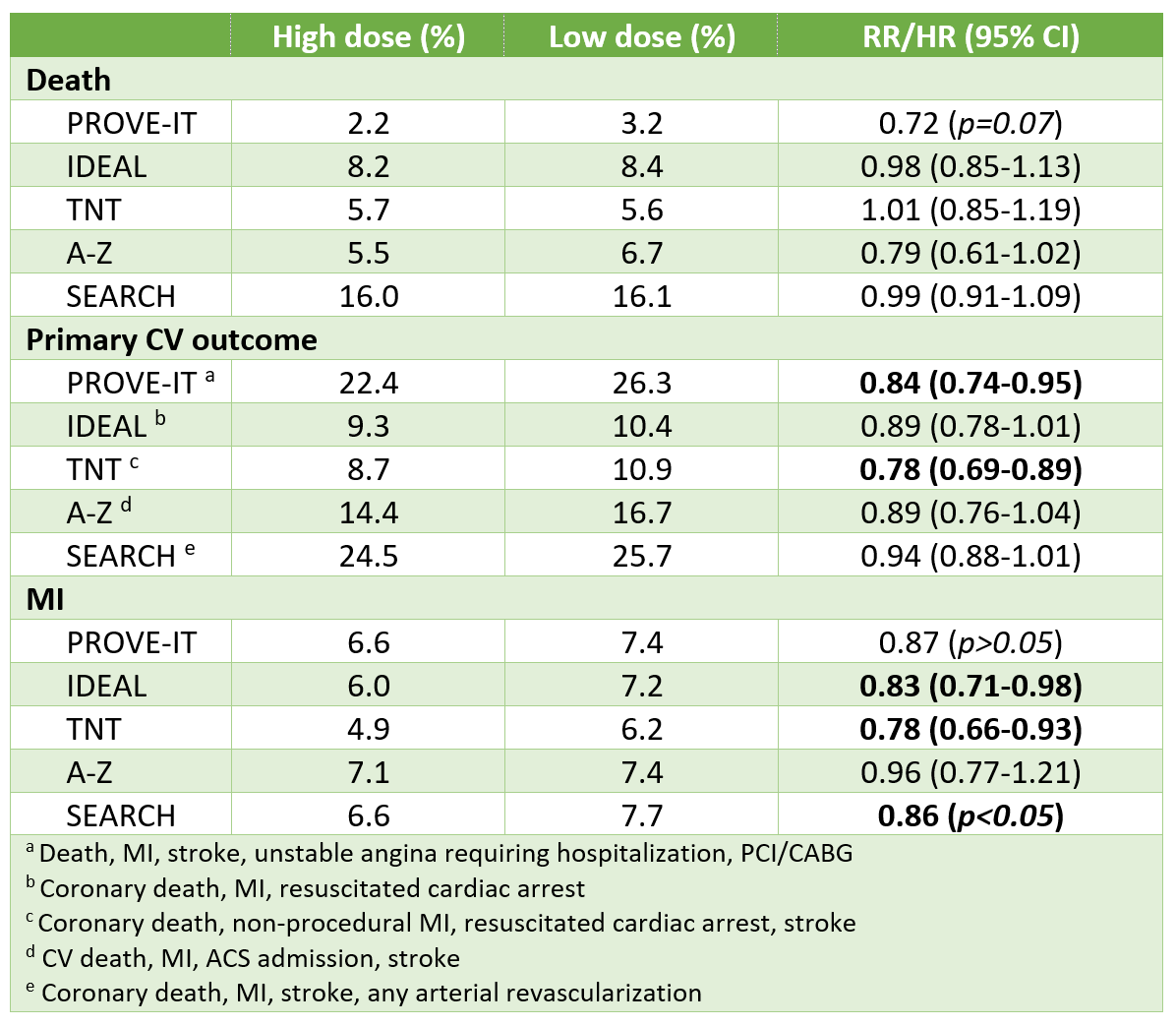INVEST - Verapamil- vs atenolol-based HTN treatment in CAD
Bottom line:
Although INVEST technically demonstrated "equivalence" of a HTN regimen based primarily on verapamil SR + trandolapril versus atenolol + hydrochlorothiazide in patients with CAD & HTN, this does not generalize to patients with (1) HF or LV dysfunction or (2) recent MI without contraindication for a beta-blocker.
Additionally, this likely does not generalize to patients on better evidence-based thiazides (chlorthalidone or indapamide), & possibly not to other beta-blockers.
Overall, there was no clinically relevant benefit of the verapamil-based regimen in CAD that would justify using this agent over a beta-blocker in this population.
Patients (n=22,576)
- Included
- Age 50+ y
- CAD, clinically stable, defined as any of:
- Remote MI >3 months ago;
- Stenosis of >50% of at least 1 coronary artery on angiography;
- "Classic" angina
- Ischemia on 2+ non-invasive investigations (EKG, echo, and/or nuclear imaging)
- Hypertension (HTN)
- Exclusion
- HF NYHA functional class IV (I-III could be enrolled)
- Taking beta-blockers for an MI that occurred <1 year
- Typical study patient
- Age 66 y (~33% >70 y)
- Female 52%
- Inclusion criteria
- Angina 67%
- Coronary stenosis on angiogram 39%
- MI 32%
- Abnormal stress test 21%
- PMHx
- CABG or PCI 27%
- Stroke 5%
- HF (NYHA I-III) 5-6%
- Current smoker 12%
- Dyslipidemia 56%
- Diabetes 28%
- BP 150/86 mm Hg
- HR 76 bpm
- Meds
- Antiplatelet 57%
- Lipid-lowering 37%
- Hormone replacement therapy 18% of women
Interventions
- Both groups received treatment for HTN to target office-based BP <140/90 mm Hg (<130/85 mm Hg for patients with diabetes or renal dysfunction)
- I: Verapamil SR-based HTN regimen
- Step 1: Verapamil SR 240 mg PO once daily (if HF, diabetes, or renal impairment: also add trandolapril 2 mg/d)
- Step 2: Add trandolapril 2 mg PO daily
- Step 3: Increase verapamil to 180 mg PO BID & trandolapril to 2 mg PO BID
- Step 4: Add hydrochlorothiazide 25 mg PO daily
- Steps 5+: Max doses of verapamil 480 mg/d, trandolapril 8 mg/d, hydrochlorothiazide 100 mg/d, non-beta-blocker non-study antihypertensive
- At 2 y, 82% on verapamil SR
- C: Atenolol-based HTN regimen
- tep 1: Atenolol 50 mg PO once daily (if HF, diabetes, or renal impairment: also add trandolapril 2 mg/d)
- Step 2: Add hydrochlorothiazide 25 mg PO daily
- Step 3: Increase both atenolol & hydrochlorothiazide to BID
- Step 4: Add trandolapril 2 mg/d
- Steps 5+: Max doses of atenolol 200 mg/d, hydrochlorothiazide 100 mg/d, trandolapril 8 mg/d, non-CCB non-study antihypertensive
- At 2 y, 77% taking atenolol
Results @ mean 2.7 years
- Vitals @ year 2
- BP reduction of ~19/10 mm Hg in both groups
- Achieved BP <140/90 mm Hg: 71.7% vs 70.7%
- Mean resting HR 73 bpm vs 69 bpm
- Primary outcome (death, non-fatal MI, non-fatal stroke): 9.9% vs 10.2%, relative risk (RR) 0.98 (0.90-1.06)
- Death: 7.75% vs 7.9%
- Non-fatal MI: 1.3% in both groups
- Non-fatal stroke: 1.2% vs 1.3%
- Angina:
- Baseline: 1.5 episodes/week in both groups
- At 2 years: 1.3 vs 1.6 episodes/week (p=0.02)
- Adverse events:
- Lightheadedness: 0.4% vs 0.6%
- Symptomatic bradycardia: 0.7% vs 1.3%
- Dyspnea: 1% vs 0.7%
- Wheezing: 0.2% vs 0.4%
- Subgroup analyses:
- Different effect based on whether patients had HF (possibly ~5% absolute risk reduction with beta-blockers in primary outcome) versus those who did not (no difference)
- Otherwise, no other baseline characteristics had a significant subgroup effect
Generalizability
- Population widely representative CAD population, with key caveats:
- First, those with an MI in the last year who were already on a beta-blocker were excluded. Thus, this trial likely selected out patients who may benefit most from beta-blockers.
- Second, this trial included patients with clinical HF. Notably, although only 5-6% of the population, there appeared to be much worse outcomes in those receiving verapamil subgroup, which is consistent with previous concerns of HF-related mortality due to the negative inotropic effect of non-dihydropyridine CCBs like verapamil. It should therefore be avoided in this population.
- Third, there was generally poor use of CAD secondary prevention therapies such as ASA & lipid-lowering, & uncharacteristically high use of hormone replacement therapy (55% of enrolled patients were female & 18% of them were receiving HRT despite a confirmed CAD history). This would be expected to increase the underlying risk of primary outcome events in both treatment groups.
- Multiple considerations regarding the intervention arms are required to interpret the results:
- First, the interventions represent BP-lowering "regimens" focused on using verapamil or atenolol, rather than a true head-to-head comparison of these agents;
- Second, although it lowers BP, atenolol seems to reduce the risk of CV events less than antihypertensive agents from other classes in patients with HTN. Similarly, hydrochlorothiazide is a weaker antihypertensive agent & generally has less evidence supporting its use than other thiazides, which have a clearer signal for benefit. This combination may have therefore been disadvantaged versus using a beta-blocker + thiazide combination with more robust supporting evidence (e.g. bisoprolol plus chlorthalidone).
- Third, adherence to the primary drug of the regimen (verapamil & atenolol) as well as to BP goals was fairly poor, with only 75-80% in each group still taking this drug & only ~70% with BP <140/90 mm Hg at year 2.
Internal validity
- Low risk of allocation bias due to appropriate sequence generation & allocation concealment (centralized, automated Internet-based randomization with permuted blocks).
- As this trial was a "prospective, randomized, open-label, blinded-endpoint" (PROBE) trial, it is by default at high risk of performance & detection bias due to knowledge of clinicians & patients of the allocated treatment
- The risk of performance bias was minimized with a standardized treatment algorithm for HTN & a similarly low proportion of patients (~70%) achieved their BP target. Additionally, few patients had revascularization procedures & there were similar rates of crossover between groups
- Investigators attempted to minimize the risk of detection bias by adjudication of events by a committee unaware of treatment allocation, however, they could not eliminate this bias as well as if they would have blinded patients and clinicians to allocation to verapamil or atenolol. Given that this was a feasible option with a few minor changes to the study HTN treatment algorithm, it is not possible to give the investigators "a pass" for this.
- Low risk of attrition bias as analyses followed intention-to-treat principles, & loss-to-follow-up was low at ~2-3% in both groups
- This trial was technically designed as an equivalence trial, with an equivalence boundary for the relative risk of 0.83-1.20.


